Spring Security使用指南
一、基于游览器的安全
表单登陆
设置表单登陆【继承WebSecurityConfigurerAdapter进行适配】
/**
* 游览器端安全配置,当访问非登陆请求时,会在FilterSecurityInterceptor进行判断是否有权限
*/
@Configuration
public class BrowserSecurityConfig extends WebSecurityConfigurerAdapter {
// 密码的加密器,高版本必须使用
@Bean
public PasswordEncoder passwordEncoder() {
return new BCryptPasswordEncoder();
}
private AuthenticationSuccessHandler successHandler = new LoginSuccessHandler();
private AuthenticationFailureHandler failureHandler = new LoginFailureHandler();
/**
* 登陆、安全拦截配置
*/
@Override
protected void configure(HttpSecurity http) throws Exception {
http.formLogin() // 设置为基于表带验证
// 当没有进行身份认证且访问需要权限的Api时跳入到这个请求
.loginPage("/authentication/require")
// 提交表单的地址,默认/login【查看UsernamePasswordAuthenticationFilter】
.loginProcessingUrl("/authentication/commit")
// 登陆成功的处理
.successHandler(successHandler)
// 登陆失败的处理
.failureHandler(failureHandler)
.and()
.authorizeRequests() //认证的请求
.antMatchers(HttpMethod.GET,
"/authentication/require", //先访问的请求
"/authentication/commit", //提交表单的地址
"/login/user.html") //登录页
.permitAll() //允许所有
.anyRequest() //任何请求
.authenticated() //需要身份认证
.and().csrf().disable() //屏蔽csrf
}
}
@RestController
public class BrowserSecurityController {
private Logger log = LoggerFactory.getLogger(BrowserSecurityController.class);
private RedirectStrategy redirectStrategy = new DefaultRedirectStrategy();
/**
* 当没有进行身份认证且访问需要权限的Api时跳入到这个请求
* 如果没权限根据请求的方式【Ajax或者HTML】进行返回指定信息
*/
@GetMapping("/authentication/require")
@ResponseStatus(HttpStatus.UNAUTHORIZED)
public AuthenticationResponse requireAuthentication(
HttpServletRequest request, HttpServletResponse response) throws IOException, ServletException {
String requestedWith = request.getHeader("X-Requested-With");
if (!"XMLHttpRequest".equals(requestedWith)) {
log.debug("未进行身份认证,游览器请求将跳转至登陆页面");
redirectStrategy.sendRedirect(request, response, "/login/user.html");
return null;
}else {
log.debug("未进行身份认证,AJAX请求将返回状态码401");
return new AuthenticationResponse(
request.getRequestURI(), "未登陆", HttpStatus.UNAUTHORIZED.value());
}
}
}
/**
* 用户登陆成功
*/
public class LoginSuccessHandler implements AuthenticationSuccessHandler {
private ObjectMapper objectMapper = new ObjectMapper();
private Logger log = LoggerFactory.getLogger(LoginSuccessHandler.class);
@Override
public void onAuthenticationSuccess(
HttpServletRequest request,
HttpServletResponse response,
Authentication authentication) throws IOException, ServletException {
log.debug("用户{}登陆成功", authentication.getPrincipal());
SimpleResponse simpleResponse = new SimpleResponse(String.valueOf(HttpStatus.OK.value()), "登陆成功");
response.setContentType("application/json;charset=utf-8");
response.getWriter().write(objectMapper.writeValueAsString(simpleResponse));
response.flushBuffer();
}
}
/**
* 用户登陆失败
*/
public class LoginFailureHandler implements AuthenticationFailureHandler {
private Logger log = LoggerFactory.getLogger(LoginFailureHandler.class);
private ObjectMapper objectMapper = new ObjectMapper();
@Override
public void onAuthenticationFailure(
HttpServletRequest request,
HttpServletResponse response,
AuthenticationException exception) throws IOException, ServletException {
log.info("登录失败");
response.setStatus(HttpStatus.OK.value());
response.setContentType("application/json;charset=UTF-8");
SimpleResponse simpleResponse = new SimpleResponse(String.valueOf(HttpStatus.INTERNAL_SERVER_ERROR.value()), exception.getMessage());
response.getWriter().write(objectMapper.writeValueAsString(simpleResponse));
}
}
/**
* 实现 UserDetailsService 接口,用户获取用户登陆信息
*/
@Service
public class SecurityUserDetailsServiceImpl implements UserDetailsService {
private Logger log = LoggerFactory.getLogger(SecurityUserDetailsServiceImpl.class);
@Autowired
private UserService userService;
// 过呢根据用户名进行登陆
@Override
public UserDetails loadUserByUsername(String username) throws UsernameNotFoundException {
log.debug("根据用户名{}查找用户", username);
// 查询user
User user = userService.getUserByUserName(username);
// 用户不存在
if (user== null) {
throw new UsernameNotFoundException( "用户名" + username + "账户不存在");
}
return user;
}
}
/*
* 实现UserDetails满足UserDetailsService需要返回的类型
*/
public class User implements UserDetails {
private Integer id;
private String username;
private String password;
// 权限信息
@Override
public Collection<? extends GrantedAuthority> getAuthorities() {
return AuthorityUtils.createAuthorityList("admin");
}
@Override
public String getPassword() {
return this.password;
}
@Override
public String getUsername() {
return this.username;
}
// 账户没有过期
@Override
public boolean isAccountNonExpired() {
return true;
}
// 账户没有锁定
@Override
public boolean isAccountNonLocked() {
return true;
}
// 密码没有过期
@Override
public boolean isCredentialsNonExpired() {
return true;
}
// 账户是否可用【注销?】
@Override
public boolean isEnabled() {
return true;
}
//=======================Getter/Setter=======================
}
请求经过过滤器的流程图

图片验证码
/**
* 验证码生成工具类
*/
@Configuration
@ConditionalOnProperty(prefix = "login.verify.image", name = "enable")
@EnableConfigurationProperties(ImageCodeProperties.class)
public class ImageCodeUtil {
private Logger log = LoggerFactory.getLogger(ImageCodeUtil.class);
private ImageCodeProperties imageCodeProperties;
public ImageCodeUtil(ImageCodeProperties imageCodeProperties) {
this.imageCodeProperties = imageCodeProperties;
}
/**
* code为生成的验证码
* codePic为生成的验证码BufferedImage对象
*/
public ImageValidateCode generateCodeAndPic() {
Long expireDate = imageCodeProperties.getExpireDate(); // 过期时间
int imageWidth = imageCodeProperties.getImageWidth(); // 定义图片的width
int imageHeight = imageCodeProperties.getFontHeight(); // 定义图片的height
int codeCount = imageCodeProperties.getCodeCount(); // 定义图片上显示验证码的个数
int fontHeight = imageCodeProperties.getFontHeight(); // 字体高度
int offsetX = imageCodeProperties.getOffsetX(); // 验证码生成X轴间隔
int offsetY = imageCodeProperties.getOffsetY(); // 验证码生成Y轴间距
String fontName = imageCodeProperties.getFontName(); // 字体
char[] codeSequence = imageCodeProperties.getCodeSequence(); // 生成序列
// 定义图像buffer
BufferedImage buffImg = new BufferedImage(imageWidth, imageHeight, BufferedImage.TYPE_INT_RGB);
Graphics graphics = buffImg.getGraphics();
// 创建一个随机数生成器类
Random random = new Random();
// 将图像填充为白色
graphics.setColor(Color.WHITE);
graphics.fillRect(0, 0, imageWidth, imageHeight);
// 创建字体,字体的大小应该根据图片的高度来定。
Font font = new Font(fontName, Font.BOLD, fontHeight);
// 设置字体。
graphics.setFont(font);
// 画边框。
graphics.setColor(Color.BLACK);
graphics.drawRect(0, 0, imageWidth - 1, imageHeight - 1);
// 随机产生30条干扰线,使图象中的认证码不易被其它程序探测到。
graphics.setColor(Color.BLACK);
for (int i = 0; i < 0; i++) {
int x1 = random.nextInt(imageWidth);
int y1 = random.nextInt(imageHeight);
int x2 = random.nextInt(imageWidth);
int y2 = random.nextInt(imageHeight);
graphics.drawLine(x1, y1, x1 + x2, y1 + y2);
}
// randomCode用于保存随机产生的验证码,以便用户登录后进行验证。
StringBuffer randomCode = new StringBuffer();
int red = 0;
int green = 0;
int blue = 0;
// 随机产生codeCount数字的验证码。
for (int i = 0; i < codeCount; i++) {
// 得到随机产生的验证码数字。
String code = String.valueOf(codeSequence[random.nextInt(codeSequence.length)]);
// 产生随机的颜色分量来构造颜色值,这样输出的每位数字的颜色值都将不同。设置为230避免使用纯白色
red = random.nextInt(230);
green = random.nextInt(230);
blue = random.nextInt(230);
// 用随机产生的颜色将验证码绘制到图像中。
graphics.setColor(new Color(red, green, blue));
graphics.drawString(code, (i + 1) * offsetX, offsetY);
// 将产生的四个随机数组合在一起。
randomCode.append(code);
}
ImageValidateCode imageCode = new ImageValidateCode(randomCode.toString(), buffImg);
if (expireDate != null){
imageCode.setExpireDate(Instant.now().getEpochSecond() + expireDate);
}
log.debug("生成图片验证码{}", imageCode.getCode());
return imageCode ;
}
}
@ConfigurationProperties(prefix = "login.verify.image", ignoreUnknownFields = true)
public class ImageCodeProperties {
private static final int DEFAULT_IMAGE_WIDTH = 90;
private static final int DEFAULT_IMAGE_HEIGHT = 90;
private static final int DEFAULT_CODE_COUNT = 4;
private static final int DEFAULT_FONT_HEIGHT = 18;
private static final int DEFAULT_IMAGE_OFFSET_X = 15;
private static final int DEFAULT_IMAGE_OFFSET_Y = 16;
private static final String DEFAULT_FONT_NAME = "微软雅黑";
private static final char[] DEFAULT_CODE_SEQUENCE = { 'A', 'B', 'C', 'D', 'E', 'F', 'G', 'H', 'J', 'K', 'L', 'M','N', 'P', 'Q', 'R', 'S', 'T', 'U', 'V', 'W', 'X', 'Y', 'Z', '2', '3', '4', '5', '6', '7', '8', '9' };
private Long expireDate = 60L; // 过期时间
private int imageWidth = DEFAULT_IMAGE_WIDTH; // 定义图片的width
private int imageHeight = DEFAULT_IMAGE_HEIGHT; // 定义图片的height
private int codeCount = DEFAULT_CODE_COUNT; // 定义图片上显示验证码的个数
private int fontHeight = DEFAULT_FONT_HEIGHT; // 字体高度
private int offsetX = DEFAULT_IMAGE_OFFSET_X; // 验证码生成X轴间隔
private int offsetY = DEFAULT_IMAGE_OFFSET_Y; // 验证码生成Y轴间距
private String fontName = DEFAULT_FONT_NAME; // 字体
private char[] codeSequence = DEFAULT_CODE_SEQUENCE; // 生成序列
//=======================Getter/Setter=======================
}
/*
* 获得验证码的Controller
*/
@ConditionalOnProperty(prefix = "login.verify.image", value = "enable", havingValue = "true")
@RestController
public class ImageCodeController {
// spring工具类用于操作session
private SessionStrategy sessionStrategy = new HttpSessionSessionStrategy();
@Autowired
private ImageCodeUtil imageCodeUtil;
public static final String SESSION_IMAGE_VERIFY_CODE = "SESSION_IMAGE_VERIFY_CODE";
@GetMapping("/verify/image/code")
public void getVerifyCode(HttpServletRequest request, HttpServletResponse response) throws IOException {
ImageValidateCode imageCode = imageCodeUtil.generateCodeAndPic();
// 设置响应的类型格式为图片格式
response.setContentType("image/jpeg");
// 禁止图像缓存。
response.setHeader("Pragma", "no-cache");
response.setHeader("Cache-Control", "no-cache");
response.setDateHeader("Expires", 0);
// 写入图片
ImageIO.write(imageCode.getCodePic(), "jpg", response.getOutputStream());
response.getOutputStream().flush();
// code放入session
imageCode.setCodePic(null);
sessionStrategy.setAttribute(new ServletWebRequest(request),SESSION_IMAGE_VERIFY_CODE,imageCode);
}
}
/**
* 验证码校验Filter,需要在BrowserSecurityConfig中在UsernamePasswordAuthenticationFilter
* 前配置http.addFilterBefore(imageValidateCodeFilter, UsernamePasswordAuthenticationFilter.class)
*/
public class ImageValidateCodeFilter extends OncePerRequestFilter {
@Autowired
private AuthenticationFailureHandler authenticationFailureHandler;
private SessionStrategy sessionStrategy = new HttpSessionSessionStrategy();
public ImageValidateCodeFilter(AuthenticationFailureHandler authenticationFailureHandler) {
this.authenticationFailureHandler = authenticationFailureHandler;
}
@Override
protected void doFilterInternal(HttpServletRequest request, HttpServletResponse response, FilterChain filterChain) throws ServletException, IOException {
// 是登陆请求而且为POST
if(StringUtils.equals("/authentication/commit", request.getRequestURI()) && StringUtils.equalsIgnoreCase(request.getMethod(), "POST")) {
try {
validate(new ServletWebRequest(request));
filterChain.doFilter(request, response);
} catch (ValidateCodeException e) {
authenticationFailureHandler.onAuthenticationFailure(request, response, e);
}
}else {
filterChain.doFilter(request, response);
}
}
private void validate(ServletWebRequest servletWebRequest) throws ServletRequestBindingException{
ImageValidateCode codeInSession = (ImageValidateCode) sessionStrategy.getAttribute(servletWebRequest, ImageCodeController.SESSION_IMAGE_VERIFY_CODE);
String codeInRequest = ServletRequestUtils.getStringParameter(servletWebRequest.getRequest(),"imageCode");
if(StringUtils.isEmpty(codeInRequest)) {
throw new ValidateCodeException("提交的验证码不能为空");
}
if(codeInSession == null) {
throw new ValidateCodeException("验证码不存在");
}
if(codeInSession.compareExpired()) {
sessionStrategy.removeAttribute(servletWebRequest, ImageCodeController.SESSION_IMAGE_VERIFY_CODE);
throw new ValidateCodeException("验证码已过期");
}
if(!StringUtils.equalsIgnoreCase(codeInRequest, codeInSession.getCode())) {
throw new ValidateCodeException("验证码不匹配");
}
// 匹配成功
sessionStrategy.removeAttribute(servletWebRequest, ImageCodeController.SESSION_IMAGE_VERIFY_CODE);
}
}
记住我
/**
* Security配置,部分信息省略
*/
@Configuration
public class BrowserSecurityConfig extends WebSecurityConfigurerAdapter {
// 创建表语句在JdbcTokenRepositoryImpl包含
@Bean
public PersistentTokenRepository persistentTokenRepository(DataSource dataSource) {
JdbcTokenRepositoryImpl jdbcTokenRepository = new JdbcTokenRepositoryImpl();
jdbcTokenRepository.setDataSource(dataSource);
return jdbcTokenRepository;
}
/**
* 登陆、安全拦截配置
*/
@Override
protected void configure(HttpSecurity http) throws Exception {
http.addFilterBefore(imageValidateCodeFilter, UsernamePasswordAuthenticationFilter.class)
//基于表带验证
.formLogin()
//当没有进行身份认证且访问需要权限的Api时跳入到这个请求
.loginPage("/authentication/require")
.loginProcessingUrl("/authentication/commit")
.successHandler(successHandler)
.failureHandler(failureHandler)
.and()
// 会加入RememberMeAuthenticationFilter
.rememberMe() //启用rememberMe
.tokenRepository(persistentTokenRepository())
.userDetailsService(userDetailsService)
.tokenValiditySeconds(60 * 60 * 24 * 7) //记住我的有效时间
.rememberMeParameter("rememberMe") //rememberMe参数名称
.and()
.authorizeRequests() //认证的请求
.antMatchers(HttpMethod.GET,
"/authentication/require", //先访问的请求
"/authentication/commit", //提交表单的地址
"/login/user.html") //登录页
.permitAll() //允许所有
.anyRequest() //任何请求
.authenticated() //需要身份认证
.and().csrf().disable() //屏蔽csrf
}
}
手机验证码
// 伪短信验证码生成
@Configuration
@ConditionalOnProperty(prefix = "login.verify.sms", name = "enable")
@EnableConfigurationProperties(SmsCodeProperties.class)
public class SmsCodeUtil {
private Logger log = LoggerFactory.getLogger(SmsCodeUtil.class);
private SmsCodeProperties smsCodeProperties;
public SmsCodeUtil(SmsCodeProperties smsCodeProperties) {
this.smsCodeProperties = smsCodeProperties;
}
/**
* code为生成的验证码,此过程要发送短信
*/
public SmsValidateCode generateCode(String mobile) {
Long expireDate = smsCodeProperties.getExpireDate(); // 过期时间
int codeCount = smsCodeProperties.getCodeCount(); // 定义短信验证码的个数
SmsValidateCode smsCode = new SmsValidateCode(RandomStringUtils.randomNumeric(codeCount), mobile);
if (expireDate != null){
smsCode.setExpireDate(Instant.now().getEpochSecond() + expireDate);
}
log.debug("生成短信验证码{}", smsCode.getCode());
return smsCode ;
}
}
@ConfigurationProperties(prefix = "login.verify.sms", ignoreUnknownFields = true)
public class SmsCodeProperties {
private static final int DEFAULT_CODE_COUNT = 4;
private static final Long DEFAULT_EXPIRE_DATE = 300L;
private Long expireDate = DEFAULT_EXPIRE_DATE; // 过期时间
private Integer codeCount = DEFAULT_CODE_COUNT; // 长度
//=======================Getter/Setter=======================
}
//短信验证码请求的URL
@RestController
@ConditionalOnProperty(prefix="login.verify.sms", name = "enable")
public class SmsCodeController {
private Logger log = LoggerFactory.getLogger(SmsCodeController.class);
public static final String SMS_CODE_MOBILE_PREFIX = "SMS_CODE_MOBILE_";
@Autowired
private SmsCodeUtil smsCodeUtil;
// spring工具类用于操作session
private SessionStrategy sessionStrategy = new HttpSessionSessionStrategy();
@GetMapping("/verify/sms/code/{mobile}", produces = MimeTypeUtils.APPLICATION_JSON_VALUE)
public SimpleResponse getVerifyCode(@PathVariable("mobile") String mobile, HttpServletRequest request, HttpServletResponse response) throws IOException {
SmsValidateCode smsValidateCode = smsCodeUtil.generateCode(mobile);
log.info("给{}手机发送验证短信,验证码{}", smsValidateCode.getMobile(), smsValidateCode.getCode());
sessionStrategy.setAttribute(new ServletWebRequest(request), SMS_CODE_MOBILE_PREFIX + mobile, smsValidateCode);
SimpleResponse simpleResponse = new SimpleResponse();
simpleResponse.setContent("短信发送成功");
simpleResponse.setCode("200");
return SimpleResponse;
}
}
// 短信验证码校验
public class SmsValidateCodeFilter extends OncePerRequestFilter {
@Autowired
private AuthenticationFailureHandler authenticationFailureHandler;
private SessionStrategy sessionStrategy = new HttpSessionSessionStrategy();
public SmsValidateCodeFilter(AuthenticationFailureHandler authenticationFailureHandler) {
this.authenticationFailureHandler = authenticationFailureHandler;
}
@Override
protected void doFilterInternal(HttpServletRequest request, HttpServletResponse response, FilterChain filterChain) throws ServletException, IOException {
// 是登陆请求而且为POST
if(StringUtils.equals("/authentication/sms/commit", request.getRequestURI()) && StringUtils.equalsIgnoreCase(request.getMethod(), "POST")) {
try {
validate(new ServletWebRequest(request));
filterChain.doFilter(request, response);
} catch (ValidateCodeException e) {
authenticationFailureHandler.onAuthenticationFailure(request, response, e);
}
}else {
filterChain.doFilter(request, response);
}
}
private void validate(ServletWebRequest servletWebRequest) {
String questInMobile = null;
String questInCode = null;
try {
questInMobile = ServletRequestUtils.getRequiredStringParameter(servletWebRequest.getRequest(), "mobile");
questInCode = ServletRequestUtils.getRequiredStringParameter(servletWebRequest.getRequest(), "code");
}catch (ServletRequestBindingException e) {
throw new ValidateCodeException("提交的短信验证码不能为空");
}
SmsValidateCode smsValidateCode = (SmsValidateCode)sessionStrategy.getAttribute(servletWebRequest, SmsCodeController.SMS_CODE_MOBILE_PREFIX + questInMobile);
if(StringUtils.isEmpty(questInMobile)) {
throw new ValidateCodeException("提交的手机号不能为空");
}
if(StringUtils.isEmpty(questInCode)) {
throw new ValidateCodeException("提交的短信验证码不能为空");
}
if(smsValidateCode == null) {
throw new ValidateCodeException("手机号" + questInMobile + "短信验证码不存在");
}
if(smsValidateCode.compareExpired()) {
throw new ValidateCodeException("短信验证码已过期");
}
if(!StringUtils.equalsIgnoreCase(questInCode, smsValidateCode.getCode())) {
throw new ValidateCodeException("验证码不匹配");
}
}
}
// 校验通过时,ProviderManager挑选对应Provider加载用户信息【权限】
public class SmsCodeAuthenticationProvider implements AuthenticationProvider {
private Logger log = LoggerFactory.getLogger(SmsCodeAuthenticationProvider.class);
private UserService userService;
@Override
public Authentication authenticate(Authentication authentication) throws AuthenticationException {
log.debug("根据手机号{}查找用户", authentication.getPrincipal());
SmsCodeAuthenticationToken smsCodeAuthenticationToken = (SmsCodeAuthenticationToken) authentication;
User user = userService.getUserByMobile((String) smsCodeAuthenticationToken.getPrincipal());
return new SmsCodeAuthenticationToken(user.getUsername(),user.getPassword(),user.getAuthorities());
}
@Override
public boolean supports(Class<?> authentication) {
return SmsCodeAuthenticationToken.class.isAssignableFrom(authentication);
}
public void setUserService(UserService userService) {
this.userService = userService;
}
}
/**
* 短信认证的Token
*/
public class SmsCodeAuthenticationToken extends AbstractAuthenticationToken {
private static final long serialVersionUID = SpringSecurityCoreVersion.SERIAL_VERSION_UID;
private Object principal;
private Object credentials;
public SmsCodeAuthenticationToken(Object principal, Object credentials) {
super(null);
this.principal = principal;
this.credentials = credentials;
setAuthenticated(false);
}
public SmsCodeAuthenticationToken(Object principal, Object credentials,
Collection<? extends GrantedAuthority> authorities) {
super(authorities);
this.principal = principal;
this.credentials = credentials;
super.setAuthenticated(true); // must use super, as we override
}
public Object getCredentials() {
return this.credentials;
}
public Object getPrincipal() {
return this.principal;
}
public void setAuthenticated(boolean isAuthenticated) throws IllegalArgumentException {
if (isAuthenticated) {
throw new IllegalArgumentException(
"Cannot set this token to trusted - use constructor which takes a GrantedAuthority list instead");
}
super.setAuthenticated(false);
}
@Override
public void eraseCredentials() {
super.eraseCredentials();
}
}
/**
* Security配置,部分信息省略
*/
@Configuration
public class BrowserSecurityConfig extends WebSecurityConfigurerAdapter {
/**
* 登陆、安全拦截配置
*/
@Override
protected void configure(HttpSecurity http) throws Exception {
http.addFilterBefore(imageValidateCodeFilter, UsernamePasswordAuthenticationFilter.class)
.addFilterBefore(smsValidateCodeFilter, UsernamePasswordAuthenticationFilter.class)
//基于表带验证
.formLogin()
//当没有进行身份认证且访问需要权限的Api时跳入到这个请求
.loginPage("/authentication/require")
.loginProcessingUrl("/authentication/commit")
.successHandler(successHandler)
.failureHandler(failureHandler)
.and()
// 会加入RememberMeAuthenticationFilter
.rememberMe() //启用rememberMe
.tokenRepository(persistentTokenRepository())
.userDetailsService(userDetailsService)
.tokenValiditySeconds(60 * 60 * 24 * 7) //记住我的有效时间
.rememberMeParameter("rememberMe") //rememberMe参数名称
.and()
.authorizeRequests() //认证的请求
.antMatchers(HttpMethod.GET,
"/authentication/require", //先访问的请求
"/authentication/commit", //提交表单的地址
"/login/user.html") //登录页
.permitAll() //允许所有
.anyRequest() //任何请求
.authenticated() //需要身份认证
.and().csrf().disable() //屏蔽csrf
}
}
第三方登陆【以QQ为例】
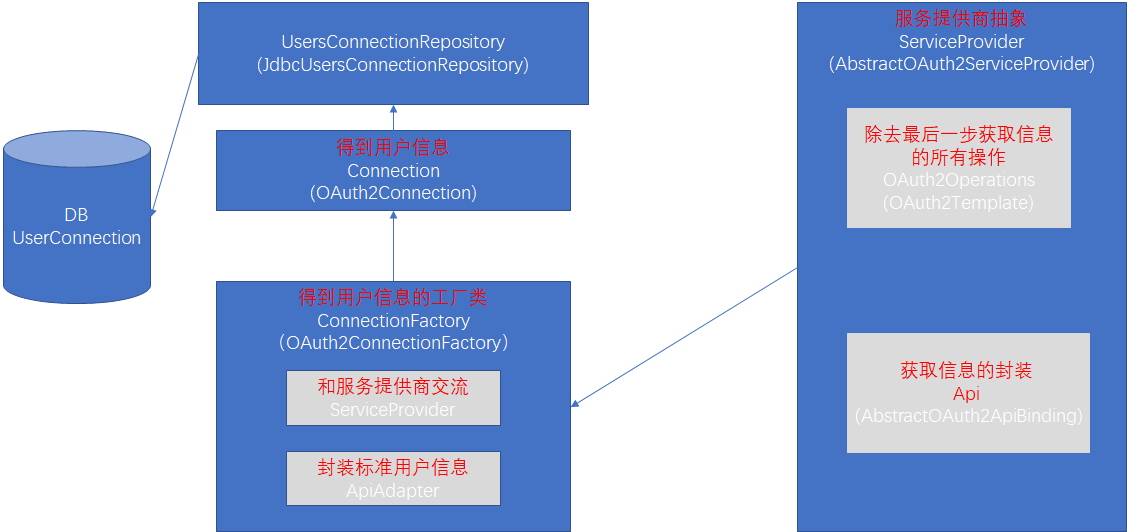
QQ登陆
public class QQUserInfo {
/**
* 返回码
*/
private String ret;
/**
* 如果ret<0,会有相应的错误信息提示,返回数据全部用UTF-8编码。
*/
private String msg;
/**
*
*/
private String openId;
/**
* 不知道什么东西,文档上没写,但是实际api返回里有。
*/
private String is_lost;
/**
* 省(直辖市)
*/
private String province;
/**
* 市(直辖市区)
*/
private String city;
/**
* 出生年月
*/
private String year;
/**
* 用户在QQ空间的昵称。
*/
private String nickname;
/**
* 星座
*/
private String constellation;
/**
* 大小为30×30像素的QQ空间头像URL。
*/
private String figureurl;
/**
* 大小为50×50像素的QQ空间头像URL。
*/
private String figureurl_1;
/**
* 大小为100×100像素的QQ空间头像URL。
*/
private String figureurl_2;
/**
* 大小为40×40像素的QQ头像URL。
*/
private String figureurl_qq_1;
/**
* 大小为100×100像素的QQ头像URL。需要注意,不是所有的用户都拥有QQ的100×100的头像,但40×40像素则是一定会有。
*/
private String figureurl_qq_2;
/**
* 性别。 如果获取不到则默认返回”男”
*/
private String gender;
/**
* 标识用户是否为黄钻用户(0:不是;1:是)。
*/
private String is_yellow_vip;
/**
* 标识用户是否为黄钻用户(0:不是;1:是)
*/
private String vip;
/**
* 黄钻等级
*/
private String yellow_vip_level;
/**
* 黄钻等级
*/
private String level;
/**
* 标识是否为年费黄钻用户(0:不是; 1:是)
*/
private String is_yellow_year_vip;
//=======================Getter/Setter=======================
}
/**
* 获取QQ用户信息
*/
public interface QQ {
QQUserInfo getUserInfo();
}
/**
* 获取QQ用户信息实现,继承AbstractOAuth2ApiBinding完成用户信息获取
*/
public class QQImpl extends AbstractOAuth2ApiBinding implements QQ{
// 获取openid【用户的唯一标识】的URL
private static final String GET_OPENID_URL = "https://graph.qq.com/oauth2.0/me?access_token={0}";
// 获取用户信息的URL,accessToken会因为TokenStrategy.ACCESS_TOKEN_PARAMETER自动带上
private static final String GET_USER_INFO_URL = "https://graph.qq.com/user/get_user_info?oauth_consumer_key={0}&openid={1}";
// 申请QQ互联的APP ID
private String oauthConsumerKey;
// 用户openid【用户的唯一标识】
private String openid;
public QQImpl(String accessToken, String oauthConsumerKey) {
super(accessToken, TokenStrategy.ACCESS_TOKEN_PARAMETER);
this.oauthConsumerKey = oauthConsumerKey;
// 获取openid
String openidResult = getRestTemplate().getForObject(MessageFormat.format(GET_OPENID_URL, accessToken), String.class);
if(StringUtils.isEmpty(openidResult)) {
throw new RuntimeException("openid获取失败");
}
this.openid = StringUtils.substringBetween(openidResult, "\"openid\":\"", "\"}");
}
@Override
public QQUserInfo getUserInfo() {
// 填充数据
String url = MessageFormat.format(GET_USER_INFO_URL, oauthConsumerKey, openid);
String userInfoJson = getRestTemplate().getForObject(url, String.class);
QQUserInfo qqUserInfo = null;
try {
// 解析用户信息
ObjectMapper objectMapper = new ObjectMapper();
objectMapper.configure(DeserializationFeature.FAIL_ON_UNKNOWN_PROPERTIES, false);
qqUserInfo = objectMapper.readValue(userInfoJson, QQUserInfo.class);
qqUserInfo.setOpenId(openid);
} catch (IOException e) {
throw new RuntimeException("json转换失败");
}
return qqUserInfo;
}
}
/**
* 将返回的QQ用户信息转换为标准的用户信息用于存储
*/
public class QQApiAdapter implements ApiAdapter<QQ> {
/**
* 不对网络进行检测
*/
@Override
public boolean test(QQ api) {
return true;
}
/**
* 获取用户信息
*/
@Override
public void setConnectionValues(QQ api, ConnectionValues values) {
QQUserInfo qqUserInfo = api.getUserInfo();
// 显示的用户名(QQ为昵称)
values.setDisplayName(qqUserInfo.getNickname());
// 头像(QQ头像)
values.setImageUrl(qqUserInfo.getFigureurl_qq_1());
// 个人主页(QQ没有)
values.setProfileUrl(null);
// 用户的唯一标识ID
values.setProviderUserId(qqUserInfo.getOpenId());
}
/**
* 解绑
*/
@Override
public UserProfile fetchUserProfile(QQ api) {
return null;
}
@Override
public void updateStatus(QQ api, String message) {
//发送消息等,QQ没有个人主页,时间线不能更新
}
}
/**
* 和服务提供商交换信息的类
*/
public class QQServiceProvider extends AbstractOAuth2ServiceProvider<QQ> {
// QQ登录页URL
private static final String AUTHORIZE_URL = "https://graph.qq.com/oauth2.0/authorize";
// QQ获取Token的URL
private static final String ACCESS_TOKEN_URL = "https://graph.qq.com/oauth2.0/token";
// QQ互联申请的App ID
private String oauthConsumerKey;
/**
* clientId : QQ互联申请的App ID
* clientSecret : QQ互联申请的APP Key
*/
public QQServiceProvider(String clientId, String clientSecret) {
super(new QQOAuthTemplate(clientId, clientSecret, AUTHORIZE_URL, ACCESS_TOKEN_URL));
this.oauthConsumerKey = clientId;
}
@Override
public QQ getApi(String accessToken) {
return new QQImpl(accessToken, oauthConsumerKey);
}
}
/**
* 发出请求的类
*/
public class QQOAuthTemplate extends OAuth2Template {
public QQOAuthTemplate(String clientId, String clientSecret, String authorizeUrl, String accessTokenUrl) {
super(clientId, clientSecret, authorizeUrl, accessTokenUrl);
// setUseParametersForClientAuthentication设置为true才能将clientId、clientSecret以请求参数的方式带出去
setUseParametersForClientAuthentication(true);
}
/**
* QQ返回的用户信息是text/html,所以需要处理返回类型
*/
@Override
protected RestTemplate createRestTemplate() {
RestTemplate restTemplate = super.createRestTemplate();
restTemplate.getMessageConverters().add(new StringHttpMessageConverter());
return restTemplate;
}
@Override
protected AccessGrant postForAccessGrant(String accessTokenUrl, MultiValueMap<String, String> parameters) {
String response = getRestTemplate().postForObject(accessTokenUrl, parameters, String.class);
String[] items = response.split("&");
String accessToken = StringUtils.substringAfterLast(items[0], "=");
Long expiresIn = Long.valueOf(StringUtils.substringAfterLast(items[1], "="));
String refreshToken = StringUtils.substringAfterLast(items[2], "=");
return new AccessGrant(accessToken, null, refreshToken, expiresIn);
}
}
/**
* 获取连接信息的类
*/
public class QQConnectFactory extends OAuth2ConnectionFactory<QQ> {
/**
* providerId:要与发出请求的路径最后结尾相同
* clientId:APP ID
* clientSecret:APP Key
*/
public QQConnectFactory(String providerId, String clientId, String clientSecret ) {
super(providerId, new QQServiceProvider(clientId, clientSecret), new QQApiAdapter());
}
}
@ConfigurationProperties(prefix = "qq.social", ignoreUnknownFields = true)
public class QQSocialProperties {
private String appId;
private String appKey;
private String callBackUri;
private String providerId;
//=======================Getter/Setter=======================
}
@Configuration
@ConditionalOnProperty(prefix = "qq.social", name = "enable")
@EnableConfigurationProperties(QQSocialProperties.class)
@EnableSocial
public class QQSocialConfig extends SocialConfigurerAdapter {
private DataSource dataSource;
private QQSocialProperties qqSocialProperties;
@Autowired
private UserService userService;
public QQSocialConfig(QQSocialProperties qqSocialProperties, DataSource dataSource) {
this.dataSource = dataSource;
this.qqSocialProperties = qqSocialProperties;
}
@Override
public UserIdSource getUserIdSource() {
return new AuthenticationNameUserIdSource();
}
@Override
public UsersConnectionRepository getUsersConnectionRepository(ConnectionFactoryLocator connectionFactoryLocator) {
JdbcUsersConnectionRepository jdbcUsersConnectionRepository = new JdbcUsersConnectionRepository(dataSource, connectionFactoryLocator, Encryptors.noOpText());
// 自注册,注意权限也要设置
jdbcUsersConnectionRepository.setConnectionSignUp(new ConnectionSignUp() {
@Override
public String execute(Connection<?> connection) {
User user = new User();
user.setUsername(UUID.randomUUID().toString());
userService.save(user);
return user.getUserId();
}
});
return jdbcUsersConnectionRepository;
}
@Override
public void addConnectionFactories(ConnectionFactoryConfigurer connectionFactoryConfigurer, Environment environment) {
connectionFactoryConfigurer.addConnectionFactory(
new QQConnectFactory(qqSocialProperties.getProviderId(), qqSocialProperties.getAppId(), qqSocialProperties.getAppKey()));
}
}
@Configuration
@ConditionalOnProperty(prefix = "qq.social", name = "enable")
@EnableConfigurationProperties(QQSocialProperties.class)
public class QQSpringSocialConfigurer extends SpringSocialConfigurer {
private QQSocialProperties qqSocialProperties;
// 如果是没设置setConnectionSignUp则需要设置注册页
public QQSpringSocialConfigurer(QQSocialProperties qqSocialProperties) {
this.qqSocialProperties = qqSocialProperties;
super.signupUrl("/register.html");
}
@Override
protected <T> T postProcess(T object) {
SocialAuthenticationFilter filter = (SocialAuthenticationFilter)super.postProcess(object);
filter.setFilterProcessesUrl(qqSocialProperties.getCallBackUri());
return (T) filter;
}
}
@RestController
public class UserController {
private BCryptPasswordEncoder passwordEncoder = new BCryptPasswordEncoder();
@Autowired
private UserService userService;
@Autowired
private ProviderSignInUtils providerSignInUtils;
@PostMapping("/user/register")
public String register(User user, HttpServletRequest request) {
user.setPassword(passwordEncoder.encode(user.getPassword()));
userService.save(user);
// 调用再次尝试使用第三方账户登陆
providerSignInUtils.doPostSignUp(user.getUserId(), new ServletRequestAttributes(request));
// 前台应该请求index页面
return "ok";
}
}
public class BrowserSecurityConfig extends WebSecurityConfigurerAdapter {
/**
* 获取社交账户信息
*/
@Bean
public ProviderSignInUtils providerSignInUtils(ConnectionFactoryLocator connectionFactoryLocator, UsersConnectionRepository connectionRepository){
return new ProviderSignInUtils(connectionFactoryLocator, connectionRepository);
}
}
查看绑定状态&绑定&解绑
前置需要手动@Import(ConnectController.class)并多配置一个回调接口为/connect/{providerId}
- 查看绑定状态
- 拿到已绑定的列表[/connect method=get]
- 配置视图
@Component("connect/status") public class ConnectStatusView extends AbstractView { private ObjectMapper objectMapper = new ObjectMapper(); @Override protected void renderMergedOutputModel(Map<String, Object> model, HttpServletRequest request, HttpServletResponse response) throws Exception { Map<String, List<Connection<?>>> connectionMap = (Map<String, List<Connection<?>>>)model.get("connectionMap"); Map<String, Boolean> connections = new HashMap<>(); for (Map.Entry<String, List<Connection<?>>> entry : connectionMap.entrySet()) { connections.put(entry.getKey(), !CollectionUtils.isEmpty(entry.getValue())); } response.setContentType(MimeTypeUtils.APPLICATION_JSON_VALUE); response.setCharacterEncoding(CharEncoding.UTF_8); response.getWriter().write(objectMapper.writeValueAsString(connections)); } } -
绑定&解绑
- 绑定[/connect/qq method=post]
- 解绑[/connect/wechat method=delete]
- 绑定视图&解绑视图
@Component({"connect/qqConnected", "connect/qqConnect"}) public class ConnectView extends AbstractView { @Override protected void renderMergedOutputModel( Map<String, Object> model, HttpServletRequest request, HttpServletResponse response) throws Exception { response.setCharacterEncoding(CharEncoding.UTF_8); response.setContentType(MimeTypeUtils.TEXT_HTML_VALUE); if(model.get("connections") == null) { response.getWriter().write("<h3>解绑成功</h3>"); }else { response.getWriter().write("<h3>绑定成功</h3>"); } } }
Session管理
session超时设置
server.servlet.session.timeout=PT30M
session并发控制
/**
* 登陆、安全拦截配置
*/
@Override
protected void configure(HttpSecurity http) throws Exception {
http //省略各项配置
.and()
.sessionManagement()
.invalidSessionUrl("/session/invalid") //session失效的处理URL
.maximumSessions(1) //只允许一个用户登陆,后登陆的把前登陆顶掉
//.maxSessionsPreventsLogin(true) //只允许一个用户登陆,不允许在在别的地方登陆
.expiredSessionStrategy(new BrowserSessionInformationExpiredStrategy()) //重复登陆提示
.and() //省略各项配置
}
public class BrowserSessionInformationExpiredStrategy implements SessionInformationExpiredStrategy {
@Override
public void onExpiredSessionDetected(SessionInformationExpiredEvent event) throws IOException, ServletException {
event.getResponse().setContentType(MimeTypeUtils.APPLICATION_JSON_VALUE);
event.getResponse().setCharacterEncoding(CharEncoding.UTF_8);
event.getResponse().getWriter().write("账号在别处登陆");
}
}
@RestController
public class BrowserSecurityController {
@GetMapping("/session/invalid")
@ResponseStatus(HttpStatus.UNAUTHORIZED)
public AuthenticationResponse invalidSession(HttpServletRequest request, HttpServletResponse response) throws IOException, ServletException {
String requestedWith = request.getHeader("X-Requested-With");
if (!"XMLHttpRequest".equals(requestedWith)) {
log.debug("会话过期,游览器请求将跳转至登陆页面");
redirectStrategy.sendRedirect(request, response, "/login/user.html");
}
log.debug("会话过期,AJAX请求将返回状态码401");
return new AuthenticationResponse(request.getRequestURI(), "会话超时", HttpStatus.UNAUTHORIZED.value());
}
}
集群session管理
#配置Spring-Session之后将redis存储到redis
spring.session.store-type=redis
spring.redis.host=192.168.1.158
spring.redis.port=6379
// 配置redisTemplate序列化存储为json,否则前文验证码模块等需要实现java序列化接口才可使用
@Bean
public RedisTemplate<Object, Object> redisTemplate(RedisConnectionFactory redisConnectionFactory) {
Jackson2JsonRedisSerializer<Object> jackson2JsonRedisSerializer = new Jackson2JsonRedisSerializer<Object>(Object.class);
RedisTemplate<Object, Object> template = new RedisTemplate<Object, Object>();
template.setConnectionFactory(redisConnectionFactory);
template.setKeySerializer(jackson2JsonRedisSerializer);
template.setValueSerializer(jackson2JsonRedisSerializer);
template.setHashKeySerializer(jackson2JsonRedisSerializer);
template.setHashValueSerializer(jackson2JsonRedisSerializer);
return template;
}
退出登陆
/**
* 登陆、安全拦截配置
*/
@Override
protected void configure(HttpSecurity http) throws Exception {
http //省略各项配置
.and()
.logout() // 会使session失效
//.logoutSuccessHandler() // 配置退出成功的处理器,进行扫尾工作,或者返回JSON
.logoutUrl("/authentication/out") // 退出请求的url
.logoutSuccessUrl("/logout.html") // 退出成功请求的url,默认跳转到登录页,可不配置
//.deleteCookies() // 删除cookie等操作
.and() //省略各项配置
}
二、基于App的安全
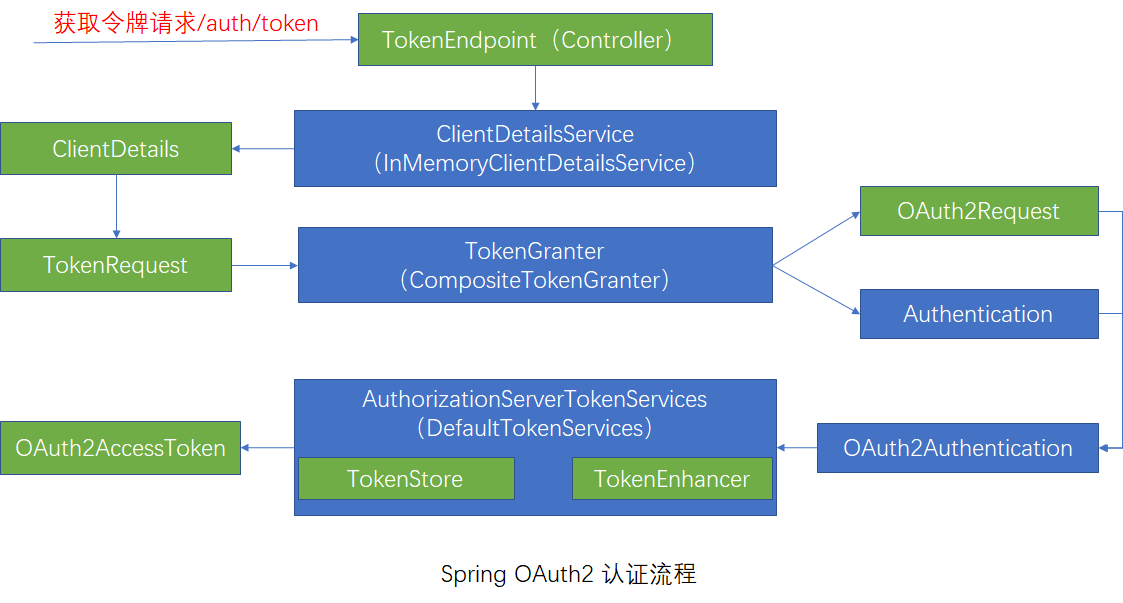
表单登陆
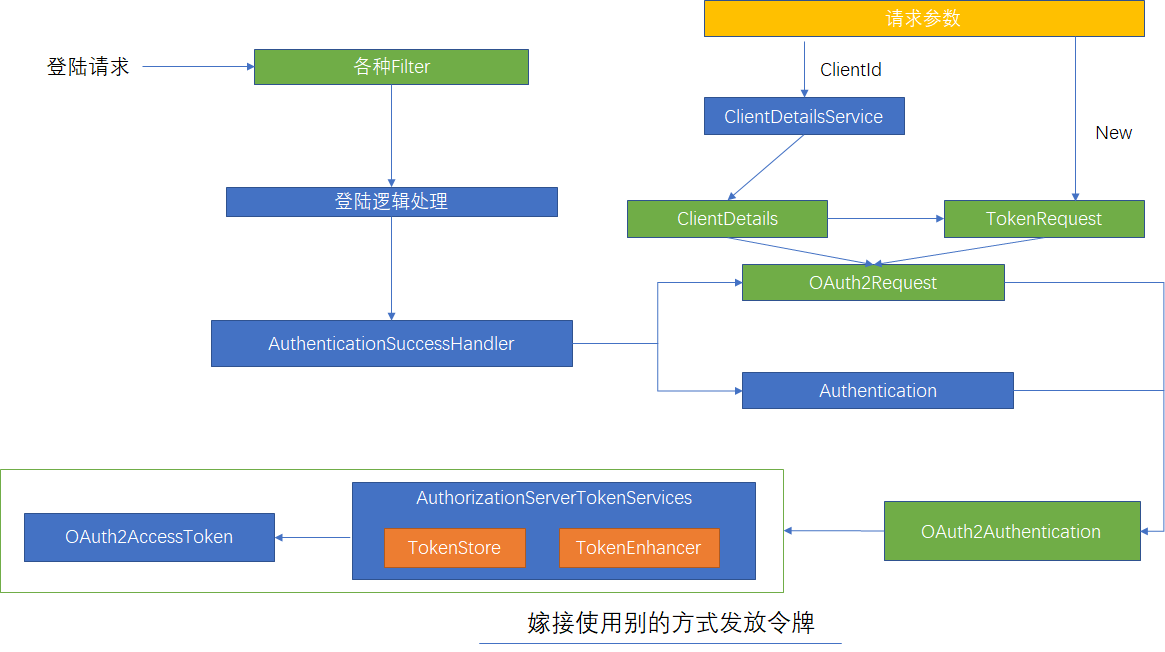
需要继承配置ResourceServerConfigurerAdapter重载public void configure(HttpSecurity http) 方法
@Configuration
public class AppResourceServerConfigurer extends ResourceServerConfigurerAdapter {
@Override
public void configure(HttpSecurity http) throws Exception {
// ....
http.userDetailsService(userDetailsService);
//表单登陆功能
FormLoginConfigurer<HttpSecurity> formLoginConfigurer = http.formLogin();
formLoginConfigurer.loginPage(coreSecurityProperties.getLoginPageUrl());
formLoginConfigurer.loginProcessingUrl(coreSecurityProperties.getAuthenticationUrl());
formLoginConfigurer.successHandler(successHandler);
formLoginConfigurer.failureHandler(failureHandler);
// ....
}
/**
* APP默认的登陆失败处理器
*/
public class DefaultLoginFailureHandler implements AuthenticationFailureHandler {
private static Logger log = LoggerFactory.getLogger(DefaultLoginFailureHandler.class);
private ObjectMapper objectMapper = new ObjectMapper();
@Override
public void onAuthenticationFailure(HttpServletRequest request, HttpServletResponse response, AuthenticationException exception) throws IOException, ServletException {
log.info("登录失败");
response.setStatus(HttpStatus.OK.value());
response.setContentType(MimeTypeUtils.APPLICATION_JSON_VALUE);
response.setCharacterEncoding(CharEncoding.UTF_8);
SimpleResponse simpleResponse = new SimpleResponse(String.valueOf(HttpStatus.INTERNAL_SERVER_ERROR.value()), exception.getMessage());
response.getWriter().write(objectMapper.writeValueAsString(simpleResponse));
}
}
/**
* APP登陆成功处理器,需要在登陆成功时发放OAuth2令牌
*/
public class DefaultLoginSuccessHandler implements AuthenticationSuccessHandler {
private ObjectMapper objectMapper = new ObjectMapper();
private static Logger log = LoggerFactory.getLogger(DefaultLoginSuccessHandler.class);
@Autowired
private ClientDetailsService clientDetailsService;
@Autowired
private AuthorizationServerTokenServices authorizationServerTokenServices;
@Autowired
private PasswordEncoder passwordEncoder;
@Override
public void onAuthenticationSuccess(HttpServletRequest request, HttpServletResponse response, Authentication authentication) throws IOException, ServletException {
response.setCharacterEncoding(CharEncoding.UTF_8);
response.setContentType(MimeTypeUtils.APPLICATION_JSON_VALUE);
//用Basic 认证传入clientId和secret
String header = request.getHeader("Authorization");
if (header == null || !header.toLowerCase().startsWith("basic ")) {
throw new AuthenticationException("没有OAuth2需要的的认证信息");
}
String[] tokens = extractAndDecodeHeader(header, request);
String clientId = tokens[0];
String secret = tokens[1];
ClientDetails clientDetails = clientDetailsService.loadClientByClientId(clientId);
if(clientDetails == null) {
response.getWriter().write(objectMapper.writeValueAsString(new AuthenticationException("clientId不正确")));
return;
}
if(!passwordEncoder.matches(secret, clientDetails.getClientSecret())) {
response.getWriter().write(objectMapper.writeValueAsString(new AuthenticationException("secret不正确")));
return;
}
TokenRequest tokenRequest = new TokenRequest(Collections.EMPTY_MAP, clientId, clientDetails.getScope(), "custom_login");
OAuth2Request oauth2Request = tokenRequest.createOAuth2Request(clientDetails);
OAuth2Authentication oAuth2Authentication = new OAuth2Authentication(oauth2Request, authentication);
OAuth2AccessToken accessToken = authorizationServerTokenServices.createAccessToken(oAuth2Authentication);
log.debug("用户{}登陆成功", authentication.getPrincipal());
response.getWriter().write(objectMapper.writeValueAsString(accessToken));
}
private String[] extractAndDecodeHeader(String header, HttpServletRequest request)
throws IOException {
byte[] base64Token = header.substring(6).getBytes("UTF-8");
byte[] decoded;
try {
decoded = Base64.getDecoder().decode(base64Token);
}
catch (IllegalArgumentException e) {
throw new BadCredentialsException(
"Failed to decode basic authentication token");
}
String token = new String(decoded, CharEncoding.UTF_8);
int delimiter = token.indexOf(":");
if (delimiter == -1) {
throw new BadCredentialsException("Invalid basic authentication token");
}
return new String[] { token.substring(0, delimiter), token.substring(delimiter + 1) };
}
}
图片验证码
注意:不能使用Session存储方式,需要将验证码存放如Redis中
@ConditionalOnProperty(prefix = "login.verify.image", value = "enable", havingValue = "true")
@Controller
public class ImageCodeController {
@Autowired
private ImageCodeUtil imageCodeUtil;
public static final String REDIS_IMAGE_VERIFY_CODE = "VERIFY_CODE:IMAGE_CODE:";
@Autowired
private RedisTemplate redisTemplate;
@GetMapping(SecurityBrowserConstants.VALIDATE_IMAGE_URL)
@ResponseBody
public void getVerifyCode(@RequestParam("device") String device, HttpServletResponse response) throws IOException {
ImageValidateCode imageCode = imageCodeUtil.generateCodeAndPic();
ImageValidateCode redisInCode = new ImageValidateCode();
redisInCode.setCode(imageCode.getCode());
redisInCode.setExpireDate(imageCode.getExpireDate());
// 设置响应的类型格式为图片格式
response.setContentType(MimeTypeUtils.IMAGE_JPEG_VALUE);
// 禁止图像缓存。
response.setHeader("Pragma", "no-cache");
response.setHeader("Cache-Control", "no-cache");
response.setDateHeader("Expires", 0);
// 写入图片
ImageIO.write(imageCode.getCodePic(), "jpeg", response.getOutputStream());
response.getOutputStream().flush();
if (imageCode.getExpireDate() == null) {
redisTemplate.boundValueOps(REDIS_IMAGE_VERIFY_CODE + device).set(redisInCode);
}else {
redisTemplate.boundValueOps(REDIS_IMAGE_VERIFY_CODE + device).set(redisInCode, imageCode.getExpireDate(), TimeUnit.MILLISECONDS);
}
}
}
/**
* 图片验证码拦截匹配器
*/
public class ImageValidateCodeFilter extends OncePerRequestFilter {
@Autowired
private CoreSecurityProperties coreSecurityProperties;
private AuthenticationFailureHandler authenticationFailureHandler;
@Autowired
private RedisTemplate redisTemplate;
public ImageValidateCodeFilter(AuthenticationFailureHandler authenticationFailureHandler) {
this.authenticationFailureHandler = authenticationFailureHandler;
}
@Override
protected void doFilterInternal(HttpServletRequest request, HttpServletResponse response, FilterChain filterChain) throws ServletException, IOException {
// 是登陆请求而且为POST
if(StringUtils.equals(coreSecurityProperties.getAuthenticationUrl(), request.getRequestURI()) && StringUtils.equalsIgnoreCase(request.getMethod(), "POST")) {
try {
validate(new ServletWebRequest(request));
filterChain.doFilter(request, response);
} catch (ValidateCodeException e) {
authenticationFailureHandler.onAuthenticationFailure(request, response, e);
}
}else {
filterChain.doFilter(request, response);
}
}
private void validate(ServletWebRequest servletWebRequest) throws ServletRequestBindingException{
String questInDevice = null;
String questInCode = null;
try {
questInDevice = ServletRequestUtils.getRequiredStringParameter(servletWebRequest.getRequest(), "device");
questInCode = ServletRequestUtils.getStringParameter(servletWebRequest.getRequest(),"imageCode");
}catch (ServletRequestBindingException e) {
throw new ValidateCodeException("提交的图片验证码参数缺失");
}
String keyName = ImageCodeController.REDIS_IMAGE_VERIFY_CODE + questInDevice;
ImageValidateCode codeInRedis = (ImageValidateCode)redisTemplate.boundValueOps(keyName).get();
if(codeInRedis == null) {
// 过期判断由Redis控制,Redis设置了过期时间,程序不判断过期行为
throw new ValidateCodeException("验证码不存在,或已过期");
}
if(!StringUtils.equalsIgnoreCase(questInCode, codeInRedis.getCode())) {
throw new ValidateCodeException("验证码不匹配");
}
// 匹配成功
redisTemplate.delete(keyName);
}
}
手机验证码
注意:不能使用Session存储方式,需要将验证码存放如Redis中
@ConditionalOnProperty(prefix = "login.verify.sms", value = "enable", havingValue = "true")
@Controller
public class SmsCodeController {
private static Logger log = LoggerFactory.getLogger(SmsCodeController.class);
public static final String SMS_CODE_MOBILE_PREFIX = "VERIFY_CODE:SMS_CODE_MOBILE:";
@Autowired
private SmsCodeUtil smsCodeUtil;
@Autowired
private RedisTemplate redisTemplate;
@Autowired
private LoginVerifySmsSender loginVerifySmsSender;
@GetMapping(value = "/verify/sms/code/{mobile}", produces = MimeTypeUtils.APPLICATION_JSON_VALUE)
@ResponseBody
public SimpleResponse getVerifyCode(@PathVariable("mobile") String mobile, @RequestParam("device") String device, HttpServletRequest request, HttpServletResponse response) throws IOException {
SmsValidateCode smsValidateCode = smsCodeUtil.generateCode(mobile);
if(loginVerifySmsSender.sendVerifyCode(smsValidateCode)) {
//发送短信
log.debug("给{}手机发送验证短信,验证码{}成功", smsValidateCode.getMobile(), smsValidateCode.getCode());
}else {
log.debug("给{}手机发送验证短信,验证码{}失败", smsValidateCode.getMobile(), smsValidateCode.getCode());
return new SimpleResponse(String.valueOf(HttpStatus.OK.value()), "短信发送失败");
}
redisTemplate.boundValueOps(SMS_CODE_MOBILE_PREFIX + device + ":" + mobile).set(smsValidateCode, smsValidateCode.getExpireDate(), TimeUnit.MILLISECONDS);
SimpleResponse simpleResponse = new SimpleResponse(String.valueOf(HttpStatus.OK.value()), "短信发送成功");
return simpleResponse;
}
}
/**
* 短信认证的Token
*/
public class SmsCodeAuthenticationToken extends AbstractAuthenticationToken {
private static final long serialVersionUID = SpringSecurityCoreVersion.SERIAL_VERSION_UID;
private Object principal;
private Object credentials;
public SmsCodeAuthenticationToken(Object principal, Object credentials) {
super(null);
this.principal = principal;
this.credentials = credentials;
setAuthenticated(false);
}
public SmsCodeAuthenticationToken(Object principal, Object credentials,
Collection<? extends GrantedAuthority> authorities) {
super(authorities);
this.principal = principal;
this.credentials = credentials;
super.setAuthenticated(true); // must use super, as we override
}
public Object getCredentials() {
return this.credentials;
}
public Object getPrincipal() {
return this.principal;
}
public void setAuthenticated(boolean isAuthenticated) throws IllegalArgumentException {
if (isAuthenticated) {
throw new IllegalArgumentException(
"Cannot set this token to trusted - use constructor which takes a GrantedAuthority list instead");
}
super.setAuthenticated(false);
}
@Override
public void eraseCredentials() {
super.eraseCredentials();
}
}
/**
* 短信认证登陆处理
*/
public class SmsAuthenticationFilter extends AbstractAuthenticationProcessingFilter {
public static final String SECURITY_FORM_MOBILE_KEY = "mobile";
private String mobileParameter = SECURITY_FORM_MOBILE_KEY;
private boolean postOnly = true;
public SmsAuthenticationFilter() {
super(new AntPathRequestMatcher("/authentication/sms/commit", "POST"));
}
public Authentication attemptAuthentication(HttpServletRequest request,
HttpServletResponse response) throws AuthenticationException {
if (postOnly && !request.getMethod().equals("POST")) {
throw new AuthenticationServiceException(
"Authentication method not supported: " + request.getMethod());
}
String mobile = obtainMobile(request);
if (mobile == null) {
mobile = "";
}
mobile = mobile.trim();
SmsCodeAuthenticationToken authRequest = new SmsCodeAuthenticationToken(mobile, null);
setDetails(request, authRequest);
return this.getAuthenticationManager().authenticate(authRequest);
}
protected String obtainMobile(HttpServletRequest request) {
return request.getParameter(mobileParameter);
}
protected void setDetails(HttpServletRequest request,
SmsCodeAuthenticationToken authRequest) {
authRequest.setDetails(authenticationDetailsSource.buildDetails(request));
}
public void setMobileParameter(String mobileParameter) {
Assert.hasText(mobileParameter, "mobileParameter parameter must not be empty or null");
this.mobileParameter = mobileParameter;
}
}
/**
* 短信验证码拦截匹配器
*/
public class SmsValidateCodeFilter extends OncePerRequestFilter {
private AuthenticationFailureHandler authenticationFailureHandler;
@Autowired
private CoreSecurityProperties coreSecurityProperties;
@Autowired
private RedisTemplate redisTemplate;
public SmsValidateCodeFilter(AuthenticationFailureHandler authenticationFailureHandler) {
this.authenticationFailureHandler = authenticationFailureHandler;
}
@Override
protected void doFilterInternal(HttpServletRequest request, HttpServletResponse response, FilterChain filterChain) throws ServletException, IOException {
// 是登陆请求而且为POST
if(StringUtils.equals(coreSecurityProperties.getSmsAuthenticationUrl(), request.getRequestURI()) && StringUtils.equalsIgnoreCase(request.getMethod(), "POST")) {
try {
validate(new ServletWebRequest(request));
filterChain.doFilter(request, response);
} catch (ValidateCodeException e) {
authenticationFailureHandler.onAuthenticationFailure(request, response, e);
}
}else {
filterChain.doFilter(request, response);
}
}
private void validate(ServletWebRequest servletWebRequest) {
String questInMobile = null;
String questInCode = null;
String questInDevice = null;
try {
questInMobile = ServletRequestUtils.getRequiredStringParameter(servletWebRequest.getRequest(), "mobile");
questInCode = ServletRequestUtils.getRequiredStringParameter(servletWebRequest.getRequest(), "code");
questInDevice = ServletRequestUtils.getRequiredStringParameter(servletWebRequest.getRequest(), "device");
}catch (ServletRequestBindingException e) {
throw new ValidateCodeException("提交的短信验证码参数缺失");
}
String keyName = SmsCodeController.SMS_CODE_MOBILE_PREFIX + questInDevice + ":" +questInMobile;
SmsValidateCode smsValidateCode = (SmsValidateCode) redisTemplate.boundValueOps(keyName).get();
if(StringUtils.isEmpty(questInMobile)) {
throw new ValidateCodeException("提交的手机号不能为空");
}
if(StringUtils.isEmpty(questInCode)) {
throw new ValidateCodeException("提交的短信验证码不能为空");
}
if(smsValidateCode == null) {
// 过期判断由Redis控制,Redis设置了过期时间,程序不判断过期行为
throw new ValidateCodeException("手机号" + questInMobile + "短信验证码不存在或已过期");
}
if(!StringUtils.equalsIgnoreCase(questInCode, smsValidateCode.getCode())) {
throw new ValidateCodeException("验证码不匹配");
}
// 匹配成功
redisTemplate.delete(keyName);
}
}
第三方登陆
- 简化验证模式需要将OpenId服务器
- 授权码模式直接将请求转给服务器即可
三、权限设置
概览
请求经过的过滤器
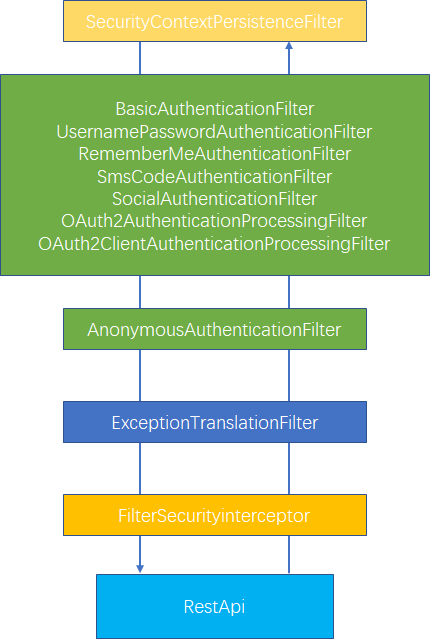
判断是否允许访问的过程
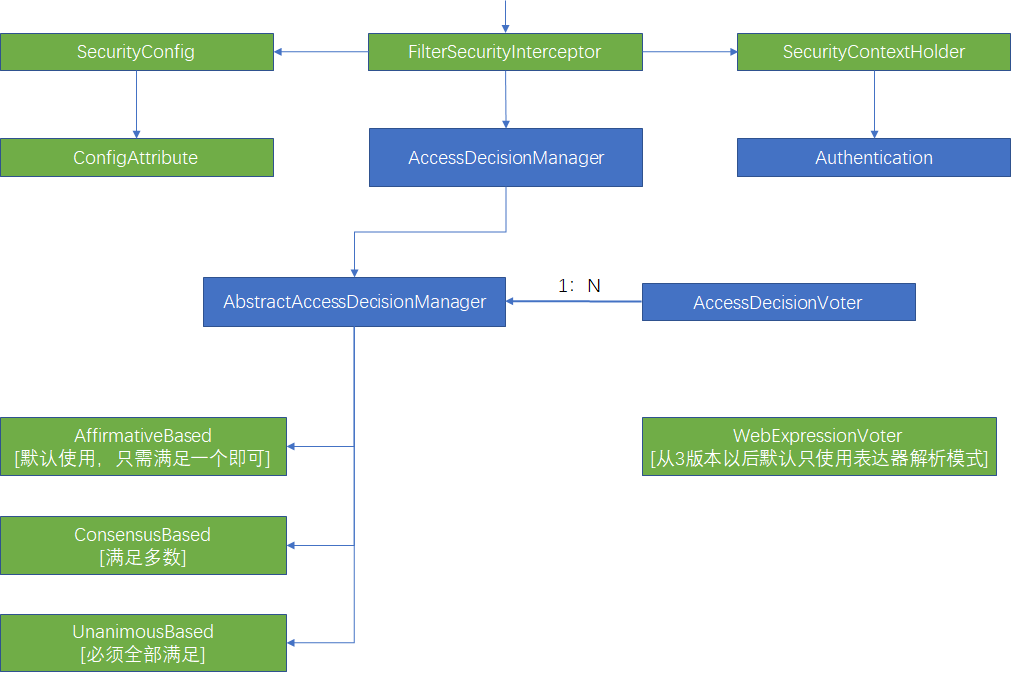
简单的只区分是否登陆
http. //省略其它配置
.formLogin()//基于表带验证
.loginPage("/authentication/require") //设置先访问的请求
.loginProcessingUrl("/authentication/commit")
.authorizeRequests() //认证的请求
.antMatchers(HttpMethod.GET,"/authentication/require", "/me")//匹配请求
.permitAll() //允许所有
.anyRequest() //认证的请求
.authenticated() //需要进行登陆身份认证
//省略其它配置
区分简单、有限角色【硬编码】
http.
.formLogin()//基于表带验证
.loginPage("/authentication/require") //设置先访问的请求
.loginProcessingUrl("/authentication/commit")
.and()
.authorizeRequests() //认证的请求
.antMatchers(HttpMethod.GET,"/authentication/require")//匹配请求
.permitAll() //允许所有
.antMatchers("/user/**") //匹配请求
.hasRole("ADMIN") //需要管理员角色,匹配的是ROLE_ADMIN,会加前缀ROLE
.antMatchers("/me") //匹配请求
.hasRole("ANONYMOUS") //匿名角色可访问【访问此请求如果未登陆会创建一个匿名授权】
//.antMatchers("/me").anonymous() 也可使用这种方式,与上等价
.anyRequest() //认证的请求
.authenticated() //需要身份认证
如果访问的URL不是指定的允许所有可访问,也不是指定角色为匿名用户可访问,那么访问时会抛出Access is denied (user is anonymous)的异常
复杂角色【一般用于后台管理】
Security权限表达式
| 表达式 | 说明 |
|---|---|
| permitAll | 永远返回true |
| denyAll | 永远返回false |
| anonymous | 当前用户是anonymous时返回true |
| authenticated | 当前用户不是anonymous时返回true |
| rememberMe | 当前用户是rememberMe时返回true |
| fullAuthenticated | 当前用户即不是rememberMe也不是anonymous时返回true |
| hasRole(role) | 当前用户拥有指定角色时返回true |
| hasAnyRole(role1,role2) | 当前用户拥有任意指定角色时返回true |
| hasAuthority(authority) | 当前用户拥有指定权限时返回true |
| hasAnyAuthority(authority1,authority2) | 当前用户拥有任意指定权限时返回true |
| hasIpAddress(Ip) | 请求匹配IP时返回true |
使用方法
//方法一:使用代码的方式指定条件,但是不能指定连续条件
expressionInterceptUrlRegistry.antMatchers("/user/add").hasRole("USER_MANAGER");
//方法二:使用表达式,可以指定连续条件
expressionInterceptUrlRegistry.antMatchers("/user/add")
.access("hasRole('USER_MANAGER') and hasIpAddress('192.168.1.100')");
//方法三:使用@PreAuthorize(express)注解
@GetMapping("/user/add")
@PreAuthorize("hasRole('ADMIN')")
public String userAdd() {
// doSomething
}